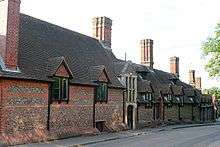Quentin Edwards
His Honour Quentin Tytler Edwards QC (1 January 1925 – 19 December 2010) was a British barrister and circuit judge.
A specialist in ecclesiastical law, he was also Chancellor of two Church of England dioceses and was a contributor to Halsbury's Laws of England.
Early life

Edwards was born in Alexandria, Egypt,[1] the son of a shipbroker, H. J. Edwards, and had an exotic childhood there.[2] While he was at Bradfield College, he struck up a friendship with John Mortimer, who became infatuated with him, leading to passionate letters from Mortimer.[3] When found by a schoolmaster, in July 1942, these resulted in Mortimer being sent down from Oxford, and Edwards being "asked not to return" to Bradfield; at the age of seventeen, during the Second World War, he then went to work on a farm on the Berkshire Downs, where he burnt the letters.[4] He also worked briefly as an apprentice at the British Thomson-Houston factory before joining the Royal Navy.[2][5]
His naval career commenced in January 1943 at Edinburgh University on a six month course for naval candidates, designed to turn schoolboys into officer material, where he was taught by Dover Wilson amongst other lecturers. A friend and fellow student was Peter Shand Kydd who, in 1969, became Princess Diana's stepfather when he married Frances Spencer, the divorced wife of Viscount Althorp. After completing his basic training in August 1943, Ordinary Seaman Edwards was posted to HMS London just in time to witness the ship's inspection by King George VI. After a brief spell on the London and further training at HMS King Alfred and elsewhere, in March 1944 he was promoted to midshipman and posted to the destroyer HMS Fury. On 21st June 1944, having been part of the D-Day bombardment force, HMS Fury detonated a ground mine off Juno Beach and was forced to beach west of Arromanches. Promotion to Sub Lieutenant followed, along with a posting in January 1945 to HMS Totland then being refitted at Durban. His final posting from November 1945 was to Landing Ship Tank HMS3504 in Calcutta before being demobbed at Helensburgh in October 1946.
Career

After the Navy he read law at the Middle Temple and was called to the bar from there in 1948. As a junior barrister, he had a mixed practice before concentrating on licencing and ecclesiastical law.[2] Unusually, he was elected as a bencher of his inn, before achieving other senior appointments, a mark of popularity.[1] In December 1974, he was appointed a Recorder,[6] in April 1975 a Queen's Counsel,[7] and in 1982 a circuit judge on the south eastern circuit.[8] He continued in that post for fifteen years, and was also Chancellor in two dioceses, Chichester and Blackburn.[1] In his specialist field of ecclesiastical law, Edwards was a contributor to Halsbury's Laws of England.[2]
Private life
On the day after he had been called to the bar,[9] 18 November 1948, at St Mary Abbots, Kensington, Edwards married Barbara Marion Guthrie, the daughter of Colonel A. Guthrie, late Royal Engineers, of Hampstead. His mother was no longer alive, and his father was living at Rannoch Lodge, Burgess Hill, West Sussex.[5] With his wife, Edwards had a daughter and two sons, Charlotte, Adam, and Simon.[10] Barbara Edwards died in 2006.[2]
The Times said of Edwards in an obituary that he was a dandy and a Wodehouse-style figure, "instantly recognisable with his abundant sidewhiskers, half-moon spectacles and rosy cheeks", and that he was at his happiest at race meetings, especially Royal Ascot, Newmarket, Cheltenham, and the greyhound races at Hackney.[1] In his ecclesiastical role, he would visit churches in the morning and then go to a race meeting in the afternoon.[1] Christopher Hill recalled that Edwards was "a stickler for propriety and good manners ... quixotic, urbane, and wickedly amusing ... occasionally irascible."[2]
Edwards lived in Highgate, North London, for some fifty years from 1954 and became a well-known supporter of community activities there, including being a founder member of the Highgate Society and a president of the Highgate Literary and Scientific Institution for six years.[1] He died on 19 December 2010.[11]
Selected publications
- With Harold Peter Bourner DOW, Public Rights of Way and Access to the Countryside (London : Shaw & Sons, 1951)
- Shaw's Guide to Rent Control and the Increase of Rents (London: Shaw & Sons, 1957)
- What is Unlawful? Does innocence begin where crime ends? Afterthoughts on the Wolfenden Report (Published for the Church of England Moral Welfare Council by the Church Information Office, 1959)
Notes
- ”His Honour Quentin Edwards” (obituary) in The Times, 31 October 2010, accessed 25 April 2020 (subscription required)
- Christopher Hill, “His Honour Quentin Edwards QC (1925–2010)” in Ecclesiastical Law Journal (2010)
- "Sir John Mortimer: creator of Rumpole of the Bailey", Archived 24 May 2010 at the Wayback Machine The Times, 17 January 2009.
- Valerie Grove, A Voyage Round John Mortimer (London: Viking, 2007), pp. 83–84
- Edwards, Quentin T., Andrews Newspaper Index Card at ancestry.co.uk, accessed 29 April 2020 (subscription required)
- The London Gazette, Issue 46430, 13 December 1974, p. 12745
- The London Gazette, Issue 56547, 18 April 1975, p. 5023
- The Solicitors' Journal, Vol. 126 (The Journal, 1982), p. 516: "Mr Quentin Tytler Edwards QC has been appointed a circuit judge and assigned to the south eastern circuit."
- "Edwards Quentin T, Guthrie Barbara M, Kensington 5c 2285" in General Index to Marriages in England and Wales, 1948
- "Edwards, Charlotte / Guthrie / Kensington 5c 1751" (1949); "Edwards Adam T / Guthrie / Kensington 5c 1544" (1951); “Edwards, Simon G / Guthrie / Kensington 5c 1330“ (1954), in General Index to Births in England and Wales
- ”EDWARDS QUENTIN TYTLER died 19 December 2010 probate Winchester” in Probate Index for England and Wales, 2010, at probatesearch.service.gov.uk, accessed 29 April 2020